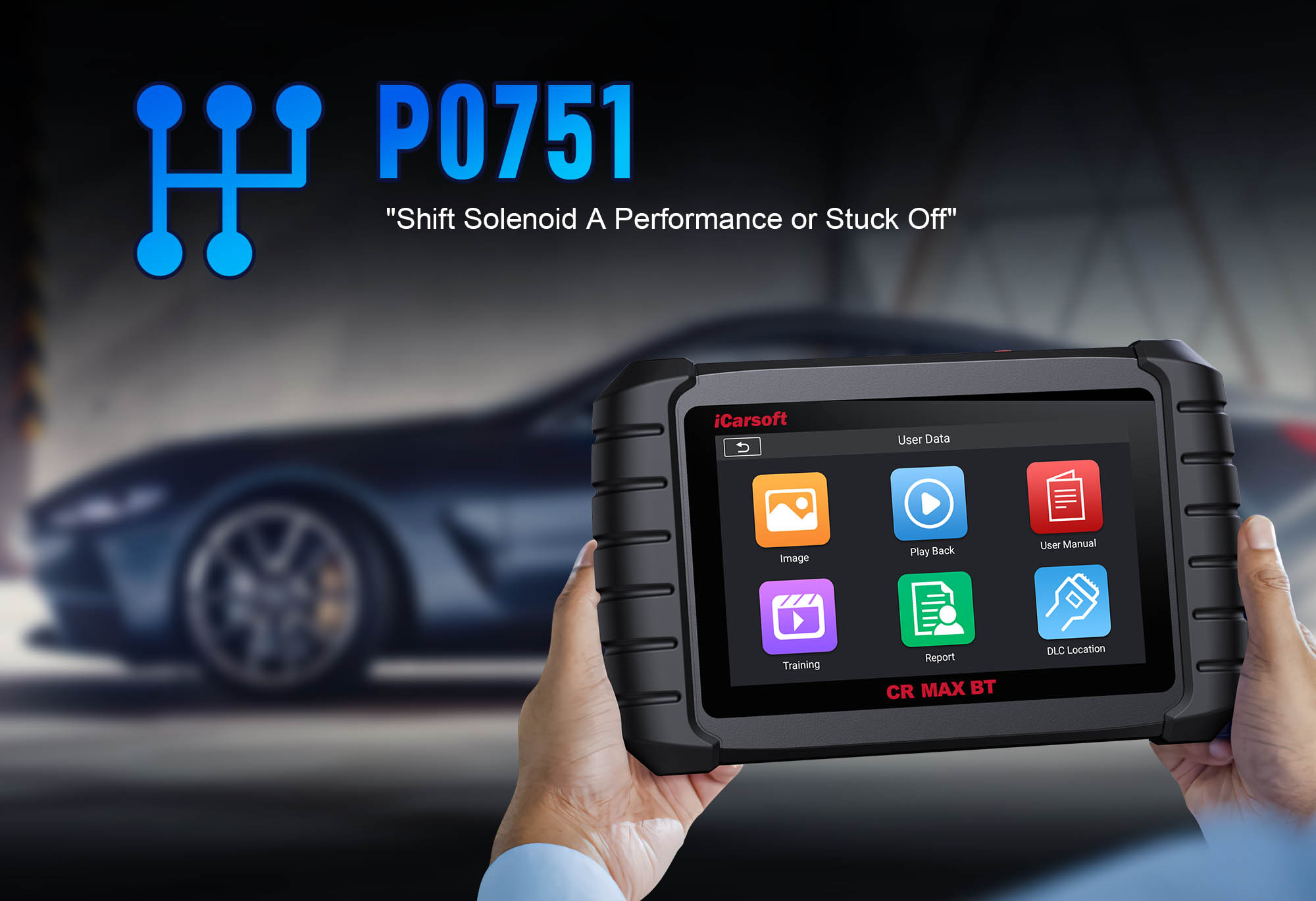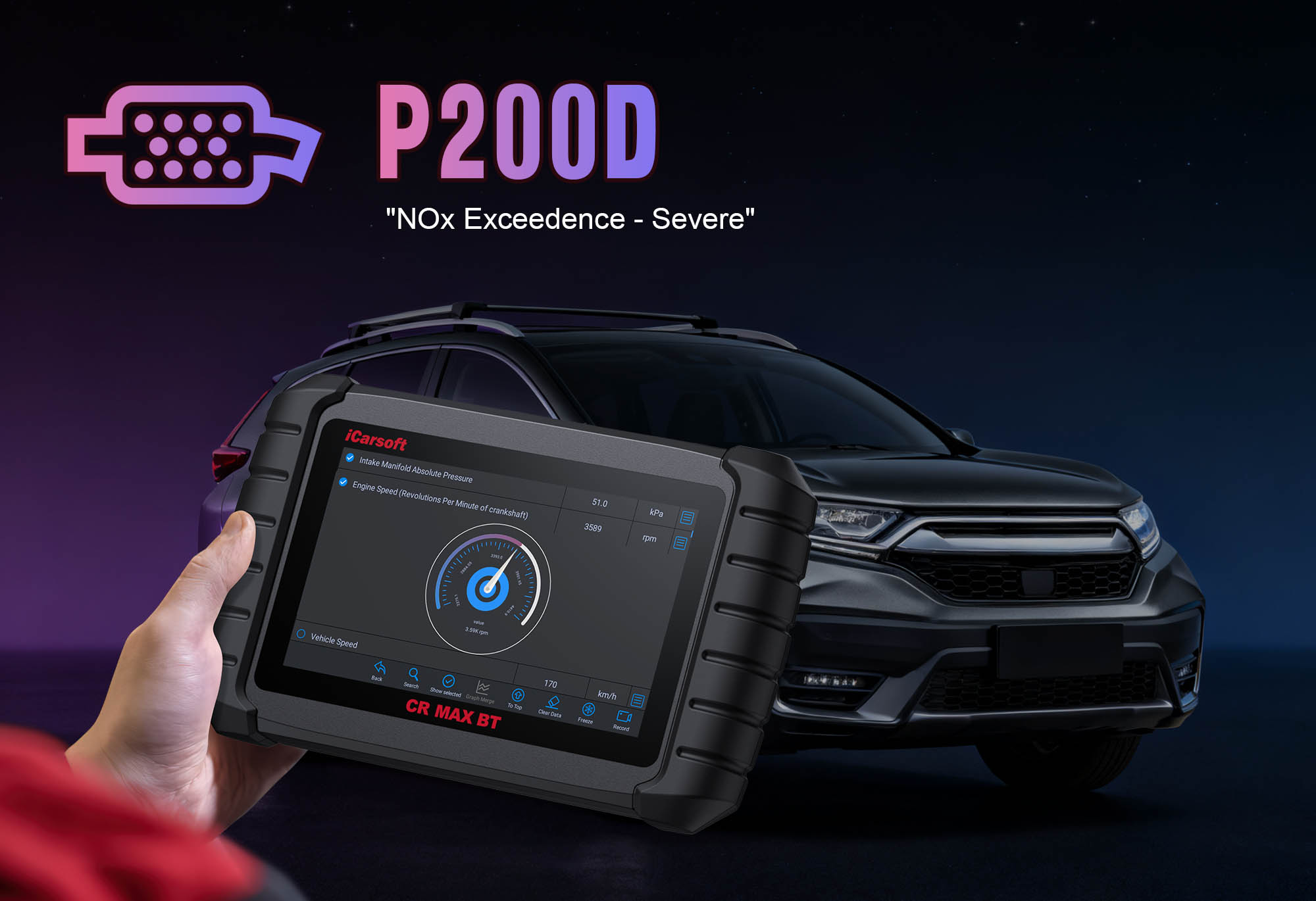Diagnose & Clear P0751 with iCarsoft CR MAX BT: Fix Shift Solenoid A Performance/Stuck Off
If your check engine light illuminates and a scan returns P0751, your vehicle’s automatic transmission is signaling a problem with Shift Solenoid A. This OBD-II code stands for "Shift Solenoid A Performance or Stuck Off"—indicating the Transmission Control Module (TCM) has detected that the solenoid responsible for activating 1st/2nd or 3rd/4th gear shifts (depending on transmission type) is either unresponsive, slow to act, or stuck in the "off" position.
Shift solenoids are electromechanical valves that regulate hydraulic pressure in the transmission, engaging/disengaging clutches or bands to change gears. Solenoid A is critical for low-to-mid gear transitions; when it malfunctions, pressure regulation fails—leading to harsh shifts, delays, or gear-sticking. Basic scanners can’t test solenoid response or pressure, but the iCarsoft CR MAX BT’s advanced features simplify pinpointing the root cause.
 iCarsoft CR MAX BT displaying Solenoid A activation status, transmission pressure, and fluid temperature for P0751 diagnosis
iCarsoft CR MAX BT displaying Solenoid A activation status, transmission pressure, and fluid temperature for P0751 diagnosis
Understanding P0751: Causes & Key Symptoms
A faulty Shift Solenoid A disrupts hydraulic pressure, leading to noticeable transmission issues:
Key Symptoms of P0751
-
Check Engine Light: Illuminates when the TCM detects Solenoid A doesn’t respond within 50–200 milliseconds (varies by manufacturer) for 2+ drive cycles.
-
Delayed Shifts: Transmission hesitates 1–2 seconds before shifting into the gear controlled by Solenoid A (e.g., 1st to 2nd).
-
Harsh Gear Changes: Shifts feel abrupt or "slamming" as pressure builds up before the solenoid finally engages.
-
Stuck in a Single Gear: Vehicle may remain in 1st gear (limp mode) or fail to shift past 2nd gear to protect the transmission.
-
Reduced Fuel Efficiency: Incorrect gear selection forces the engine to rev higher, lowering MPG by 10–15%.
-
Transmission Overheating: Friction from unregulated pressure raises fluid temperature—look for a warning light or burning odor.
Common Causes of P0751
|
Cause
|
Description
|
|
Faulty Shift Solenoid A
|
Internal electrical failure (burned coil) or mechanical sticking (valve won’t move) prevents activation—accounts for ~40% of P0751 cases.
|
|
Dirty/Contaminated Fluid
|
Debris, sludge, or metal shavings (from transmission wear) clog the solenoid valve, restricting movement.
|
|
Low Transmission Fluid
|
Insufficient fluid pressure can’t push the solenoid valve open/closed, leading to unresponsive behavior.
|
|
Damaged Wiring/Connector
|
Frayed wires, corroded terminals, or loose plugs disrupt voltage flow to the solenoid—common near hot transmission components.
|
|
Clogged Solenoid Screen/Filter
|
A blocked inlet screen on the solenoid starves it of clean fluid, causing sticking or slow response.
|
|
TCM Malfunction (Rare)
|
Faulty TCM sends incorrect voltage (too low/too high) to the solenoid, paired with communication codes (e.g., U0101).
|
Why iCarsoft CR MAX BT Excels at Diagnosing P0751
The CR MAX BT outperforms basic tools with solenoid-specific diagnostics to avoid misrepairs:
Wireless Solenoid Activation
Send direct commands to activate Solenoid A (6V low-test, 12V full-test) to verify responsiveness—hears a "click" and sees pressure spikes if functional.
Hydraulic Pressure Monitoring
Track real-time pressure changes (±50 psi) when the solenoid activates—no pressure = stuck solenoid; weak pressure = clogged screen.
Voltage Waveform Analysis
Visualize Solenoid A’s voltage patterns to spot drops (wiring issues) or no signal (TCM fault)—basic scanners only show "on/off."
3D Component Diagrams
Preloaded schematics show Solenoid A’s location (valve body under transmission pan), wiring paths, and pinouts for 80+ makes (Ford, Chevrolet, Honda, BMW).
Fluid Condition Checks
Integrates fluid temperature (175–225°F normal) and quality data to link contamination to solenoid sticking—avoids replacing a good solenoid.
Freeze Frame Data
Review stored conditions (speed, temp, gear) when P0751 triggered—e.g., failure only in cold weather = fluid viscosity issue.
Step-by-Step: Diagnose P0751 with iCarsoft CR MAX BT
-
1. Connect & Confirm the Code
Plug the CR MAX BT into the OBD-II port and pair with the app (30-second Bluetooth setup).
Select your vehicle via Auto VIN Scan or manual entry (include transmission type: 4-speed/6-speed/CVT).
Navigate to Transmission > Fault Codes > Read Codes to confirm P0751. Tap Code Details for vehicle-specific insights (e.g., "Ford: Solenoid A Response = 350ms – Over 200ms Threshold").
-
2. Locate Shift Solenoid A
Use the CR MAX BT to avoid guesswork:
Go to Component Location > Transmission > Solenoids > Shift Solenoid A.
The 3D diagram shows: Solenoid A is mounted on the valve body (access by removing the transmission pan). It has a 2–3 wire connector (power, ground, signal) and may be labeled "A" or "SSA" on the valve body.
-
3. Analyze Live Solenoid & Pressure Data
Start the engine and warm to operating temperature (10–15 minutes).
In the app, go to Transmission > Live Data > Solenoids and monitor:
- "Shift Solenoid A Status": Should toggle "On/Off" when shifting (e.g., "On" for 1st gear, "Off" for 2nd). P0751 = stuck "Off" or delayed toggling.
- "Transmission Fluid Pressure": Should rise 40–60 psi when Solenoid A activates. No change = stuck valve.
- "Solenoid A Voltage": Normal = 12V (On), 0V (Off). Erratic readings = wiring fault.
-
4. Perform Active Solenoid Activation Test
Ensure the vehicle is in Park with the parking brake engaged (safety first).
Navigate to Special Functions > Transmission > Solenoid Control > Activate Solenoid A.
Run two tests:
1. Low Voltage Test (6V): Functional solenoid clicks faintly; pressure rises ~20 psi.
2. Full Voltage Test (12V): Louder click; pressure rises 40–60 psi.
No click/pressure = faulty solenoid or no power to the circuit.
-
5. Inspect the Solenoid, Connector & Fluid
Address easy-to-fix issues first:
Fluid Check:
Use the app’s Fluid Level Guide (follow manufacturer steps: engine running, warm fluid). Low level = top off with OEM-spec fluid and retest. Dark/burnt fluid = schedule a change (contamination is likely).
Solenoid & Connector Inspection:
Remove the transmission pan (use the app’s torque spec guide for bolts). Locate Solenoid A and:
- Check for debris/sludge on the valve (clean with transmission fluid solvent if minor).
- Inspect the inlet screen (if equipped) for clogs (replace screen if dirty).
- Disconnect the solenoid connector: Look for corrosion, bent pins, or oil leaks. Clean with electrical contact cleaner.
-
6. Test the Solenoid Circuit’s Electrical Function
Validate solenoid and wiring health:
Resistance Test:
Disconnect Solenoid A from the harness. Use the app’s Multimeter Function to measure resistance across its terminals. Normal = 10–30 ohms (check app’s specs). Infinite (open) or 0 ohms (short) = replace solenoid.
Voltage Supply Test:
With the ignition "On" (engine off), measure voltage at the solenoid’s power pin (via the connector). Normal = 12V. 0V = check TCM fuse (labeled "TCM" or "TRANS") or wiring to the TCM.
Continuity Test:
Check continuity between the solenoid connector and TCM (use the app’s wiring diagram). Resistance >1 ohm = broken wire—repair with heat-shrink butt connectors.
-
7. Check for Clogged Valve Body Passages
Debris in the valve body can mimic solenoid failure:
Navigate to Special Functions > Transmission > Pressure Test > Solenoid Circuit Flow Test.
The scanner measures fluid flow through Solenoid A’s passages: Reduced flow = clogged passages—requires professional cleaning (avoid DIY disassembly of the valve body).
-
8. Repair & Clear P0751
Fix the root cause (prioritize test results):
- Replace Shift Solenoid A (use OEM parts—check the app’s Part Lookup for exact fit).
- Change transmission fluid and filter (flush if contaminated with metal shavings).
- Repair damaged wiring; replace corroded connectors (apply dielectric grease).
- Professional valve body cleaning if flow test fails.
Clear the Code: Go to Transmission > Fault Codes > Clear Codes to delete P0751.
-
9. Validate the Repair
Confirm Solenoid A and transmission function correctly:
- Re-run the Activation Test: Hear clicks and see pressure spikes.
- Test drive: Drive 20–60 mph, checking for smooth 1st→2nd or 3rd→4th shifts (no delays/harshness).
- Monitor temperature: Fluid temp stays 175–225°F (no overheating).
- Re-scan: No P0751 recurrence = successful repair.
- Verify limp mode: Vehicle shifts through all gears without limiting speed.
Preventing P0751 Recurrence
The CR MAX BT helps maintain reliable solenoid performance:
-
Fluid Maintenance: Use the app’s Service Reminder to replace transmission fluid every 60,000–100,000 miles (50,000 miles for towing/heavy use).
-
Solenoid Inspection: Check Solenoid A’s screen/connector during fluid changes—clean debris before it causes sticking.
-
Connector Protection: Apply dielectric grease to the solenoid plug annually to repel moisture and corrosion.
-
Avoid Overheating: Use the CR MAX BT’s live data to monitor temperature—stop driving if it exceeds 250°F.
-
Regular Scans: Run Quick Scans quarterly to test Solenoid A’s response time (catch slowdowns early).
Conclusion
P0751’s Shift Solenoid A malfunction risks transmission damage if ignored, but the iCarsoft CR MAX BT simplifies diagnosis with targeted tests—avoiding costly mistakes like replacing a valve body when a $50 solenoid is faulty. By combining activation tests, pressure monitoring, and fluid analysis, the tool ensures you fix the root cause, restoring smooth shifts and fuel efficiency.
With the CR MAX BT, resolving "shift solenoid performance faults" becomes a precise, confidence-building process—keeping your transmission operating reliably for years.
FAQs About P0751 Code
Q: Can I drive my vehicle with P0751?
A: Only short distances (5–10 miles) in an emergency. P0751 causes harsh shifts and overheating, which can burn transmission clutches. If limp mode activates, avoid speeds over 40 mph and fix the issue within 1–2 days.
Q: How much does it cost to fix P0751?
A: Costs vary: Solenoid replacement = $60–$150 (DIY) + $100–$200 (fluid/filter); professional service = $300–$600 (includes labor); valve body cleaning = $400–$800 (if needed). The CR MAX BT saves money by avoiding unnecessary repairs.
Q: Why does P0751 come back after replacing the solenoid?
A: Common reasons: 1) Dirty fluid/filter (not changed, recontaminates the new solenoid); 2) Clogged valve body passages (not cleaned); 3) Wiring fault (not repaired); 4) TCM issue (masked by solenoid replacement). Re-run the CR MAX BT’s flow and wiring tests.
Q: Will changing transmission fluid fix P0751?
A: It depends—if P0751 is caused by mild contamination (sludge on the solenoid), a fluid change may resolve it. But if the solenoid is electrically faulty or the valve body is clogged, fluid alone won’t fix the code. Use the CR MAX BT’s activation test to confirm before changing fluid.
Q: How do I know if P0751 is the solenoid or TCM?
A: Use the CR MAX BT’s voltage test: If the solenoid receives 12V (power is good) but doesn’t activate, it’s a solenoid fault. If voltage is 0V or erratic (even with good wiring), it’s a TCM issue (look for U0101 or similar codes).

 iCarsoft CR MAX BT displaying Solenoid A activation status, transmission pressure, and fluid temperature for P0751 diagnosis
iCarsoft CR MAX BT displaying Solenoid A activation status, transmission pressure, and fluid temperature for P0751 diagnosis



